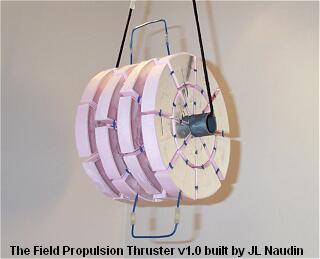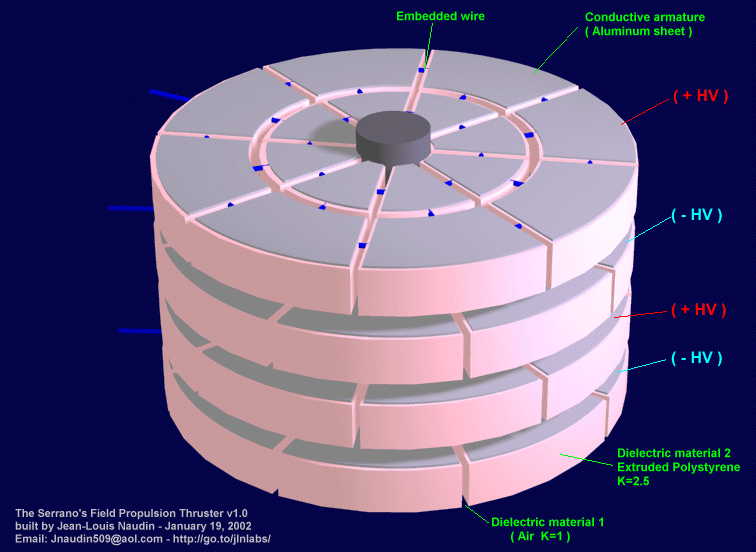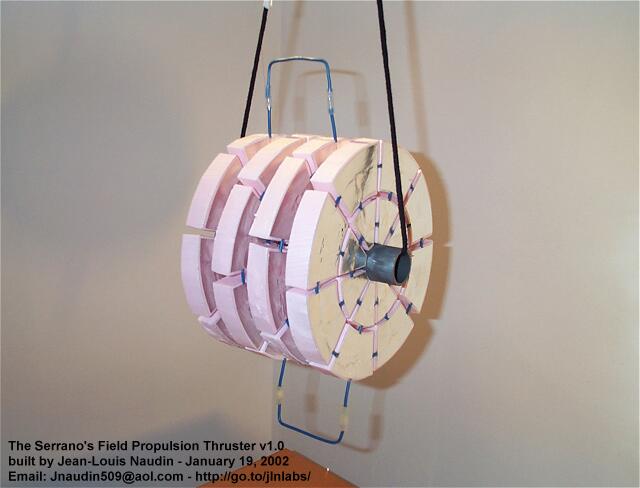

The
Serrano's Field Propulsion Thruster
SFPT
v1.0
Built and tested by
Jean-Louis Naudin
created on January
19, 2002 - JLN Labs - Last
update February 17, 2002
All
informations in this page are published free and are intended for
private/educational purposes and not for commercial applications
On October 5, 2000, the Hector Serrano's patent WO 00/58623 " Propulsion device and method employing electric fields for producing thrust " has been granted.
This patent is very close to the Aymmetrical Capacitor Thruster ( ACT ) patented by the NASA ( patent US 6,317,310 , granted on Nov 2001 ) that I have already tested successfully in Nov 18, 2001 ( see the NASA ACT v1.0 experiment ) . These two devices use the Biefeld-Brown Effect for producing a thrust Vs the surrounding medium ( this effect was discovered by Townsend Brown in 1928 in his Gravitator, see the GB Patent N°300311 filed on Nov 15, 1928 "A method of and an apparatus or machine for producing force or motion" from T.Townsend Brown ).
The Serrano's patent WO 00/58623 contains some very interesting key points :
" Such a vehicle can operate in any dielectric environnement such as air or vacuum of space " page 12, line 28
" As a result, since the device (10) employing field propulsion can propel itself without exhausting any matter in the opposite direction of vehicle motion, it can propel itself without being exposed to the environment (16) through which it is moving " page 8, line 11
" It has been discovered that a preferred effect occurs when the capacitor is initially charging, not when it is constantly charged as in a typical DC system. The charging time is associated with a drift velocity of charges. The DC device of the present invention operates with a constant charge rate that will, as the capacitor is increased in power, reach a saturation level of capacitor and begin to create a leakage current. The leakage current will continue to build up until the device suffers a dielectric breakdown where arcing occurs, thus limiting the maximum energy that can be included unto a DC device, significantly more than in a typical AC powered device " page 6, line 6
" The channels (42) also increase the field effect by allowing the lines of force to be in a generally parallel arrangement, which, as is appreciated by one of skill in the art, increases the Lorentz force effect and therefore the field propulsion effect. The Lorentz force has been observed through experimentation as an important factor in the thrust-generating phenomenon. The more parallel the lines of force are relative to each other, the larger the force effect for a given energy input. The Lorentz force is a recognized phenomenon that works partially by the forces generated between drift velocities of charges. " page 11, line 9
________________________
On January 19, 2002, I have fully replicated and tested successfully this Electric Field Propulsion Thruster patented by Hector Serrano from Gravitec Inc. ( see the photo below ).

Tested apparatus description :
I have used the same design as described in the Serrano's patent at the page 12 : << As earlier described with reference to FIG 11, the dielectric matrial in the channel 42 is preferably of a relative lower dielectric constant than the dielectric 36 on which the electrode 38 is placed to allow for a non-linear relationship to form between plates 26 and their respective electrodes. Futher, there is a layer of dielectric material between the cells 22 created by the lower dielectric 40 of lower dielectric strength as for material in the channels 42. This allows the desirable formation of the non-linearity in the field. The plate 26 can be arranged so that the channels 42 are aligned with the next set of plates as earlier described with reference to FIG 11, or staggered to cause a larger non-linearity effect, as earlier described with reference to FIG 14 >> ( see the photo above and the diagram below )

The
Serrano's Field Propulsion Thruster v1.0 specifications
|

Click here to see some construction details of the apparatus

The SFPT v1.0 is hanged on a free rotating apparatus.
The High Voltage is sent through thin wires coming from the top
and the bottom.
TESTS RESULTS ( 01-19-02 ) :
When the HV power supply is switched on, the Field Propulsion Thruster v1.0 is rapidly set in motion. The voltage used is 27 KV DC @ 480 uA. The turn speed observed is low. This is due to the low dielectric constant difference producing a weak non-linearity between the two dielectrics used in this experiment ( K=2.53 for the Polyfoam XPS and and K = 1 for the Air ).

The motion of the SFPT v1.0 and the net resulting thrust observed in the direction of the conductive armature when the High Voltage is applied confirms the field propulsion effect claimed by Hector Serrano in his patent.
See the video of Serrano's Field Propulsion Thruster v1.0 experiment
To see the videos, the free
downloadable RealPlayer is required ![]()
Click on the picture above to see the video ( 631 Kb )
Some documents references :
See also :
 The SFPT v1.0 : Tests
and measurements
The SFPT v1.0 : Tests
and measurements
 The
NASA Two Dimensional Asymmetrical Capacitor Thruster
The
NASA Two Dimensional Asymmetrical Capacitor Thruster
![]() Email : JNaudin509@aol.com
Email : JNaudin509@aol.com
Return to the JLN Labs home page